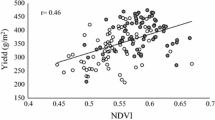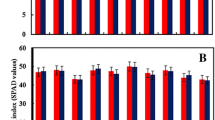Abstract
High temperature is a major environmental stress factor limiting wheat (Triticum aestivum L.) productivity. Improvement of heat tolerance in wheat is an important breeding objective. Genetic variation in cellular thermotolerance among 56 spring wheat cultivars was evaluated at the seedling stage of growth by cell membrane thermostability (CMS) and triphenyl tetrazolium chloride (TTC) assays. A subset of eight lines was also evaluated at the flowering stage using the same assays. With both assays Average thermotolerance tended to decrease from the seedling to the flowering stages. However, thermotolerance was well correlated between growth stages among the eight cultivars for both CMS (r = 0.92; p = 0.004) and TTC (r = 0.84; p = 0.050). The correlation between TTC and CMS among the eight cultivars tested at the seedling and the flowering growth stages was significant (r = 0.74; p = 0.031 and r = 0.75; p = 0.029, respectively). The same correlation was less strong, though still significant (r = 0.32; p = 0.014) across 56 cultivars at the seedling stage. In a study of the cross V747 (tolerant)/Barkaee (susceptible), broad sense heritability was estimated at 89% for TTC. Most of the genetic variance was additive. CMS in seedlings of 16 cultivars was positively and significantly (p ≤ 0.05) correlated with yields of these cultivars in each of four hot environments in Mexico, Sudan, India, and Brazil. The same correlations for TTC were positive but nonsignificant.
Similar content being viewed by others
References
Allard, R.W., 1960. Principles of plant breeding. John Wiley & Sons, New York.
Blum, A., 1988. Plant breeding for stress environments. CRC Press, Inc., Boca Raton. 201 p.
Blum, A. & A. Ebercon, 1981. Cell membrane stability as a measure of drought and heat tolerance in wheat. Crop Sci 21: 43-47.
Chen, H.H., Z.Y. Shen & P.H. Li, 1982. Adaptability of crop plants to high temperature stress. Crop Sci 22: 719-725.
Falconer, D.S., 1981. Introduction to quantitative genetics. Longman, London.
Fischer, R.A., 1986. Physiological limitations to producing wheat in semitropical and tropical environments and possible selection criteria. Proc Internat Symp Wheat for More Tropical Environments, pp. 209-230. CIMMYT/UNDP, Mexico.
Krishnan, M., H.T. Nguyen & J.J. Burke, 1989. Heat shock protein synthesis and thermal tolerance in wheat. Plant Physiol 90: 140- 145.
Kuo, C.G., H.M. Chen & H.C. Sun, 1992. Membrane thermostability and heat tolerance of vegetable leaves. In: C.G. Kuo (Ed), Adaptation of Food Crops to Temperature and Water Stress. Proc Intern Symp, pp. 160-168. Asian Vegetable Research and Development Center, Taiwan.
Lin, C-Y., Y-M. Chen & J.L. Key, 1985. Solute leakage in soybean seedlings under various heat shock regimes. Plant Cell Physiol 26: 1493-1498.
Marsh, L.E., D.W. Davis & P.H. Li, 1985. Selection and inheritance of heat tolerance in the common bean by use of conductivity. HortSci 110: 630-683.
Martineau, J.R., J.H. Williams & J.E. Specht, 1979. Temperature tolerance in soybeans. II. Evaluation of segregating populations for membrane thermostability. Crop Sci 19: 79-81.
Milliken, G.A., 1987. Comparison of TTC and electrical conductivity heat tolerance screening techniques in Phaseolus. HortScience 22: 642-645.
Ottaviano, E., M.S. Gorla, E. Pe & C. Frova, 1991. Molecular markers (RFLPs and HSPs) for the genetic dissection of thermotolerance in maize. Theor Appl Genet 81: 81-713.
Porter, D.R., H.T. Nguyen & J.J. Burke, 1994. Quantifying acquired thermal tolerance in winter wheat. Crop Sci 34: 1686-1689.
Porter, D.R., H.T. Nguyen & J.J. Burke, 1995. Genetic control of acquired thermal tolerance in wheat. Euphytica 83: 153-157.
Reynolds, M.P., E. Acevedo, O.A.A. Ageeb, S. Ahmed, M. Balota, L.J.B. Cervalho, R.A. Fischer, E. Granem, R.R. Hanchinal, C.E. Mann, L. Okuyama, L.B. Olugbemi, G. Ortiz-Ferrara, M.A. Razzaque & J.P. Tandon, 1992. Results of the first international heat stress genotype experiments. Wheat Special Report No. 14. Mexico D.F. CIMMYT.
Reynolds, M.P., M. Balota, M.I.B. Delgado, I. Amani & R.A. Fischer, 1994. Physiological and morphological traits associated with spring wheat yield under hot, irrigated conditions. Aust J Plant Physiol 21: 717-730.
Sadalla, M.M., J.F. Shanahan & J.S. Quick, 1990a. Heat tolerance in winter wheat: I. Hardening and genetic effects on membrane thermostability. Crop Sci 30: 1243-1247.
Sadalla, M.M., J.S. Quick & J.F. Shanahan, 1990b. Heat tolerance in winter wheat: II. Membrane thermostability and field performance. Crop Sci 30: 1248-1251.
Steel, R.G.D. & J.H. Torrie, 1980. Principles and procedures of statistics. McGraw-Hill Book Co., New York.
Sullivan, C.Y., N.V. Norcio & J.D. Eastin, 1977. Plant responses to high temperatures. In: Muhammed Askel & Von Borstel (Eds), Genetic Diversity in Plants, p. 301. Plenum.
Suss, K-H. & I.T. Yordanov, 1986. Biosynthetic causes of in vivoacquired thermotolerance of photosynthetic light reactions and metabolic responses of chloroplasts to heat stress. Plant Physiol 81: 192-199.
Towil, L.E. & P. Mazur, 1974. Studies on the reduction of 2,3,5-triphenyl tetrazolium chloride as a viability assay for plant tissue culture. Can J Bot 53: 1097-1102.
Warner, J.N., 1952. A method for estimating heritability. Agron J 44: 427-430.
Author information
Authors and Affiliations
Rights and permissions
About this article
Cite this article
Fokar, M., Nguyen, H.T. & Blum, A. Heat tolerance in spring wheat. I. Estimating cellular thermotolerance and its heritability. Euphytica 104, 1–8 (1998). https://doi.org/10.1023/A:1018346901363
Issue Date:
DOI: https://doi.org/10.1023/A:1018346901363




